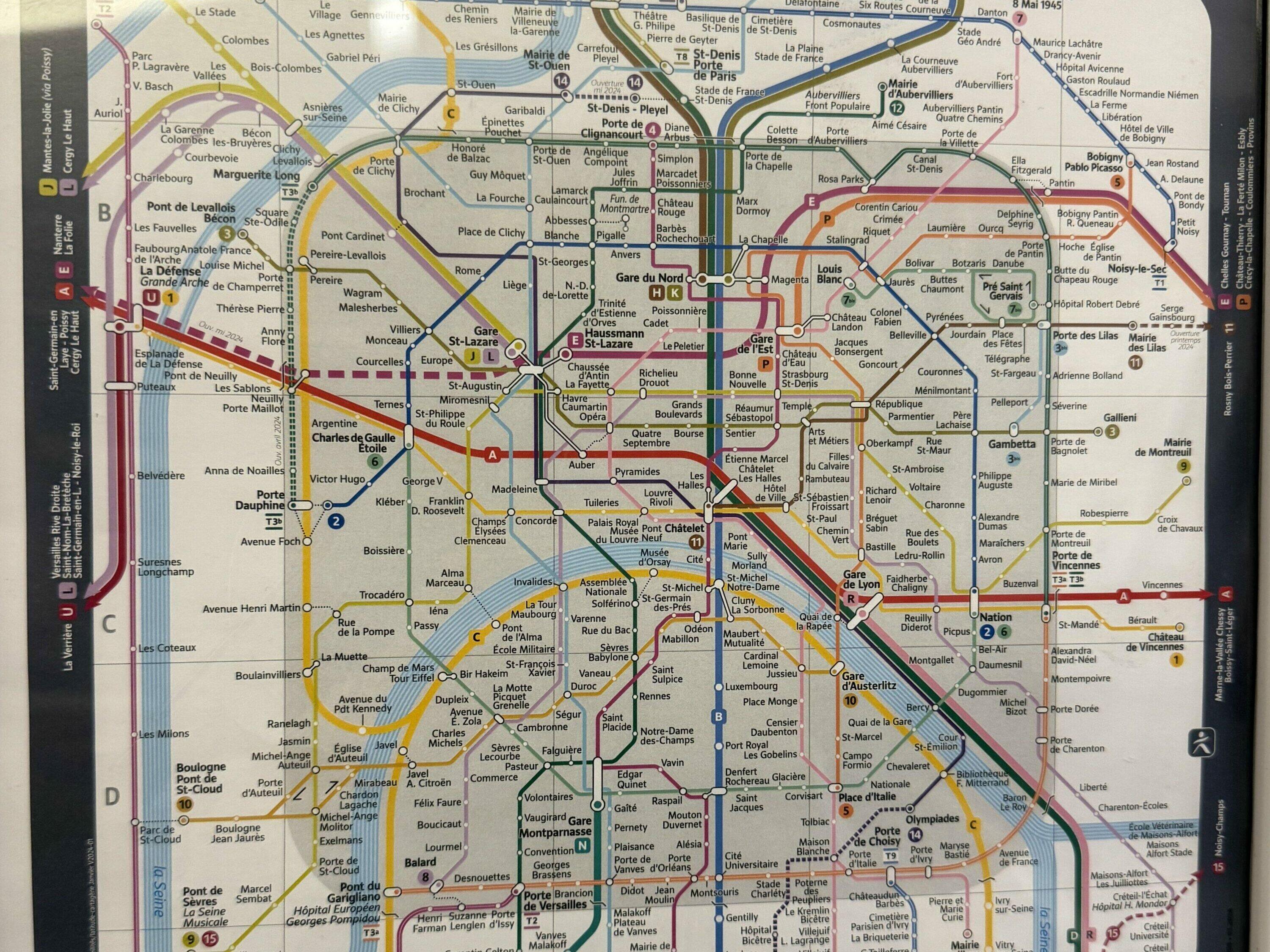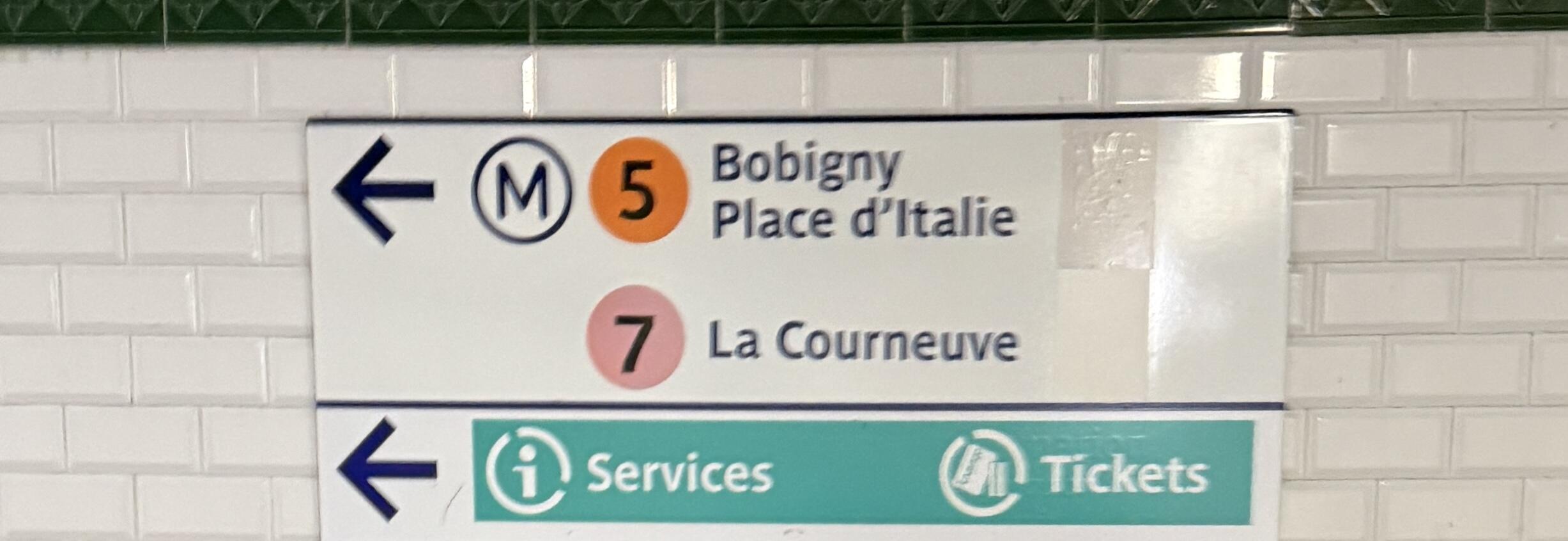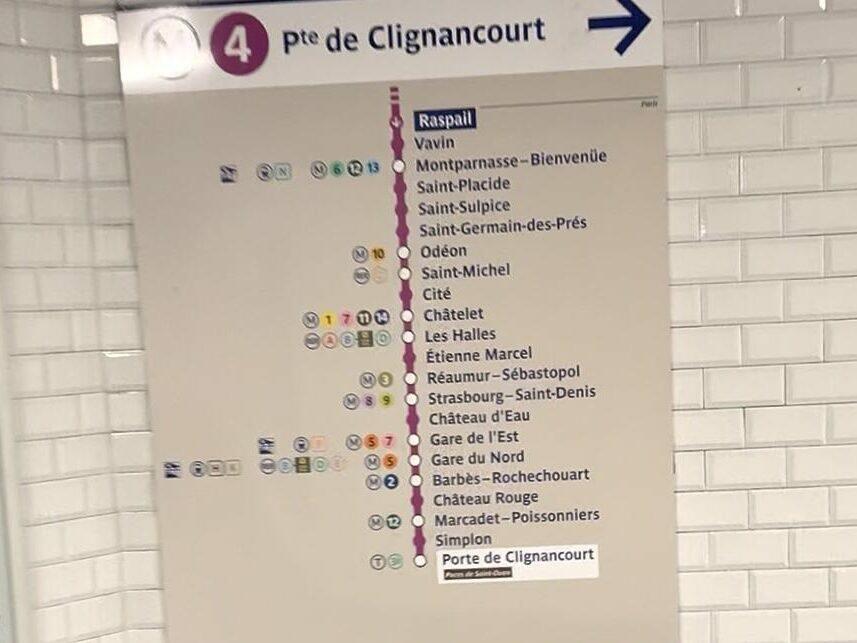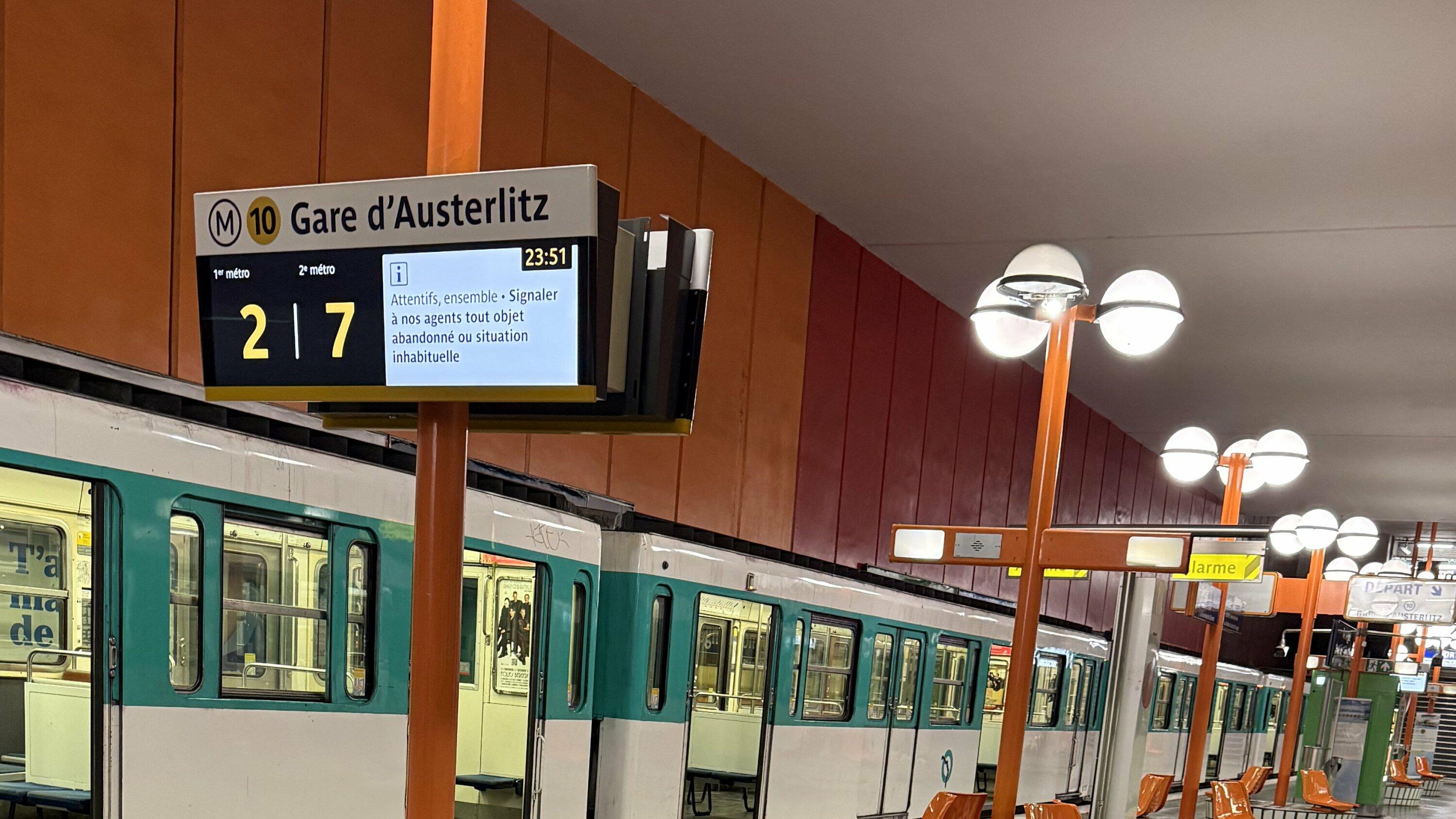Spanning 41 square miles, seeing all that Paris has to offer may seem like a daunting task, especially in a short time frame.
Why not just take a car you say? Well, Paris is currently ranked 6th in the Global Traffic Congestion Ranking, so this is easier said than done. More importantly, the City Hall in Paris is on a mission to reduce traffic in the city centre, improving the air pollution, the noise pollution, and making it much more cycle friendly, all of which we are very much in favour of!
Instead of spending precious hours sat inside a car in traffic, when in Paris, live how the Parisians do and take the 152 miles of metro lines at 132 stops zipping about below the city, one of the densest rail systems in a city!
We know for many tourists that taking public transport in a new city is daunting, that’s why we’ve created this blog for everything you need to know about taking the Paris metro!
- Structure and Maps
- Tickets
- Gates: Entry and Exit
- Metro Navigation
- Train Doors
- On the Train
- Conclusion
Structure and Maps
The Paris underground train system is split into two main categories. First you have the classic metro lines from 1 through to 14, each with their own unique colour, which cover the main central areas of Paris, predominantly within the periphery. And secondly you have the RER lines, short for Réseau Express Régional or Regional Express Network, and are labelled alphabetically A through E. They connect the suburbs to the centre of Paris and are therefore primarily used for commuting. As a tourist you are more likely to use them to go to and from the airports, to Versailles or even to Disneyland!

Before we move on to tickets, it’s important to know how to read the metro maps. The fat, pale blue line shows you where the Seine River is. You may hear or see references to “Rive Droite” (Right Bank) and “Rive Gauche” (Left Bank): the former is above the Seine and includes areas such as the Louvre, the Marais and Opera Garnier, and the latter is below and includes the Eiffel Tower, the Latin Quarter and the Pantheon.
On the map you will see the name of each stop and a little bump where this is on the line. You will not that some stops have a white dot instead. These are ones that have a change over to another line. On a view of the individual line, this is also shown as a white dot and underneath it will display the number of the metro in a circle relating to the colour of its line (e.g. 14 is purple, 12 is green etc.).

You will see that some of these white dots are actually nearly lines, this is because they have lots of lines to change onto. These are ones that we would recommend avoiding if you can, especially at rush hour, but if that’s not possible then we’d recommend using Citymapper to navigate them. They are Gare du Nord, Châtelet Les Halles, Gare de Lyon and Montparnasse.
Taking Citymapper as our must-use app for navigating Paris, simply allow it to find your location and type in the address or name of where you are going, press the green arrow on the right and see the options for how to get there. This app is great because it shows live updates, where to stand on the train for fastest exit or transfer, and which exit number to take to get to your location faster. Once you’ve found a route you like the look of, simply tap on it, press GO, and follow its instructions until you get there!
Check out the section below on how to navigate within the metro.
Tickets
Now you know where you want to go within Paris via the metro, you have to buy a ticket to get there. Single-fare tickets are currently €2.50 per journey, so, if you leave the metro and re-enter at a different station, that will count as two separate journeys. Check out the Île-de-France mobilités app for the different tickets. The traditional paper tickets are being phased out and being replaced with Navigo cards. These come in two forms. First is a physical card the size of a bank card which is an extra €2 to buy the first time but you can then top up and use indefinitely. The second way is to buy the card virtually on your phone (see below).
Watch our video here on how to purchase tickets on the metro machines as different machines have different ways of using them to get a ticket.
Ticket Types
Now there are far more tickets than we have time to explain, including reduced options, but here are the basics you may need for your journey:
- Metro-train ticket - €2.50, the basic single-journey ticket giving you access to the whole Île-de-France region excluding airports, one ticket = one entry and exit to the metro system, also valid on the RER lines.
- One way to/from airports - €13, a single-ride ticket to Orly or Charles de Gaulle airport.
- Paris-visit Pass/Paris Tour Package - €29.90 per day, access to all zones including airports, Disneyland and Versailles, unlimited travel.
- Navigo 1 day pass - €12 allowing of unlimited travel for a whole calendar day, excluding airports.
- Navigo weekly pass - €31.60 allowing for unlimited travel for a whole calendar week starting Monday, including airports.
Note: When we say “travel to airports” we are referencing the stations “Charles de Gaulle terminal 1 & 2” and “Aéroport Orly” for the named airports, you will not be able to leave the metro gates at these stops without the correct pass.
For more information we recommend checking here for the Île-de-France Mobilités app's breakdown of different tickets.
Online Tickets
To purchase tickets online on your phone, download the Île de France mobilités app, create an account, and search through their options as described below. Note that passes for a specific time period will become available in the week leading up to that point so you won't be able to by them months in advance. Don’t worry though, they don’t sell out, it is just to keep the app more streamlined.
To use your phone as a pass, simply tap your phone on the reader on the ticket gates instead. Note you don’t need to unlock your phone to make this feature work and keep a tight grip to protect your phone form prying hands, especially in less safe areas.
Gates: entry and exit
As a general rule of thumb, metro gates require you only to tap in to access the system and the RER requires you to tap both in and out. We will go through the ways to access in an out below.
To Enter
- Turnstiles: These gates usually have a turnstile AND an extra door, either tap your card or phone on the top on the coloured circle, or if you have a paper ticket and a machine that will accept it, the little slot below this, make sure to take it back after. Then simply walk through the turnstile and use your hand to push the door. These gates are very difficult to navigate if you have luggage or a pram so look for the wide entry gate which may require assistance from the desk to open, if you need.
- Automatic gates: By far the easiest, simple tap and walk through when the gates open!
To Exit
- The exits with double doors per exit point will automatically open if you go near. Sometimes they may be broken so either try another one, or if needed, just push them open if you can.
- Some doors are single doors and are large metallic ones that you have to push, sometimes they can be a bit heavy or stuck so make sure to give them a good shove, and hold it open if there is anyone coming in after you!
- Automatic gates with tap: Especially the RER, you will have the same system as the entry, upon exit. Again, just tap your phone or insert your ticket into the relevant place, and exit normally.
- Automatic gates: Very similar to the automatic entry gates, but without anywhere to tap your card, simple walk up to one with a green arrow pointing at it and walk through!
Metro navigation
All the signs within the metro system are named after the last stops on their path. So for metro line 1 that goes from left to right across the city, the left side is La Defence, and the right side is Château de Vincennes. Places that split off at the end such as line seven, will have both names in the title, such as Ivry-Villejuif.

Simply follow the signs for your colour line and then the name for the final stop in your direction towards the platform. Do note that sometimes the signs can be in awkward places round corners and you may have to go up and down a few stairs - its one of Paris’ quirks!

As you near the correct platform you will see a big board. The top of the board shows the final destination which is the direction of the metro, and below it is a big list of all the stops it goes to on this route, check that your stop or changeover is on this list and you’re ready to go!

Train doors
Now you’re on the platform, the final challenge is getting on the actual train, you can see how long it is until the next train with these signs.

There are 3 different types of train door openings: automatic, button, and lever. Automatic is easy, just hop on board, button involves pressing the button, usually in the middle of the doors, once the train has come to a complete stop. The one that stumps people the most is lever. A metal knob will be in the middle of the doors, simply pull it up and round as shown below and the doors will open. All doors automatically close by themselves.
Train Door Types
Here is a list of each style of door for the lines as of June 2025, but there are constant works on the metro so take that into consideration:
Automatic:
- Line 1
- Line 2
- Line 4
- Line 5
- Line 6
- Line 11
- Line 13
- Line 14
Button:
- Line 7
- Line 8
- Line 9
Lever:
- Line 3
- Line 10
- Line 12
There will be a beeping noise usually accompanied by orange flashing to let you know the doors are about to close, make sure you're not too near the doors as some of them will close very hard and we’ve seen fingers get trapped in them before. We don't recommend trying to jump in as the doors beep either, it can end up being fairly painful if the doors suddenly close on you! There's always another metro a couple of minutes later.
On the train and train etiquette
Now you’ve got onto the train, there are a few things you need to know. First is that you will see the whole metro line on the ceiling here - some of the trains will have a row of lights which will show the stations lit up that the train will stop at, or announce as you arrive at each station.

This can’t be relied upon though so make sure you’re aware of each stop you pass as to not miss your stop.
It does happen that sometimes while you're on the train it may not stop at the station you wanted, or will just stop at the next stop and you can usually tell if everyone on board gets off. It is usually a case of getting off the train and waiting for the next one to come in a couple of minutes time.
As for etiquette, be prepared to give up your seat for small children, pregnant people, elderly people or someone with a disability who may not be able to stand as easily. Also if the train gets crowded and you are on the fold-down seats near the doors, stand up to allow for more space. And obviously, be considerate to those around you. Our upcoming post will cover all this in much more detail, so now you've got your bearings from this post, you'll really be able to pass for a Parisian in the metro!
Conclusion
In conclusion, the metro is an incredible feat of engineering that allows you to truly get the Paris experience and make the absolute most of your time in our beautiful city, and with this blog and a little bit of first-hand experience, you’ll be an absolute pro in no time!
If you're looking for more tips, itineraries, and insights into Paris, check out our social media!
Thank you!
Thank you so much for taking the time to read our blog! We are a small Paris-based tour guide company that prioritises a boutique personal experience where we can share our passion for our heritage and community with every individual that joins us. If you'd like to take a tour then head over to our website for an unforgettable trip to the city of lights. Also, check out our social media @memories.france for everything you could need to know for coming to Paris, from how to use the metro to coffee shops closest to each major monument, there is something for everyone!
Felicity, Siobhan & the Memories France Family
Like what you see? Read our other blogs here!
- Explore Paris with Kids: Track Down the Space InvadersHunting for Space Invaders in Paris is one of the most unexpectedly fun ways to explore the city — especially with kids. These colourful tile mosaics turn Paris into a giant treasure hunt, encouraging everyone to look up, wander slowly, and discover surprising flashes of street art on rooftops, bridges, and tucked-away corners. Download the free Flash Invaders app and let the adventure begin!
- Did Marie Antoinette Really Say "Let Them Eat Cake"? The Truth Behind the MythDid Marie-Antoinette really utter the infamous words ‘Let them eat cake’? In this post, we separate fact from fiction and explore how a myth grew to define the Queen’s reputation. Discover the real story behind the legend, and why history remembers her so differently than the caricature suggests.
- Dark Paris: 10 Spine-Chilling Places to Visit with Real History Behind ThemHalloween in Paris isn’t just costumes and candy — it’s centuries of ghostly tales and dark history hidden behind elegant façades. From the silent tunnels of the Catacombs to royal tombs and old execution sites, discover 10 chilling places that reveal the City of Light’s shadowy past. This Halloween, dare to explore Paris like never before…
- Louvre Heist 2025: Stolen Crown Jewels and the Stories Behind ThemDiscover the Louvre heist of October 2025 and the priceless crown jewels taken. Explore the fascinating stories of Napoleon, Marie Amélie, and other French royals behind each piece, and learn why the Apollo Gallery is more than just a showcase of gems.
- Paris Fashion History: When Impressionist Art Put Fashion in the FrameParis may be the fashion capital of the world, but did you know that Impressionist painters were just as obsessed with style as today’s designers? From the bustle of Haussmann’s new boulevards to the elegance of suburban strolls, artists like Monet, Renoir, and Manet immortalized the clothing trends of their time. In this post, we explore how Impressionist art put fashion at the very heart of modern Parisian life.









